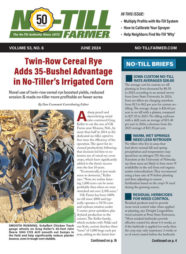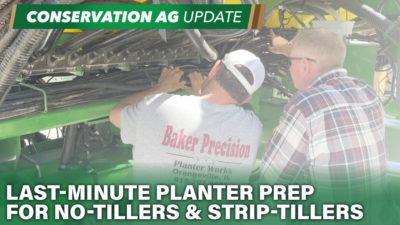Autonomous solutions in the world of agriculture are becoming increasingly common. Machines such as the Salin 247 autonomous no-till planter or Guardian Agriculture’s autonomous electric drone sprayer are already available for no-tillers to incorporate into their farm operations.
Ideally, autonomy and other precision technology on the farm should make a no-tiller’s life easier and save time and money. But one of the biggest complaints from farmers is that much of this new technology seems to be “autonomy for the sake of autonomy,” instead of solutions to existing problems on the farm.
On-Farm Trials
One grower, Tony Brannon of Puryear, Tenn., says he is used to being on the cutting edge of new agricultural innovations ever since his father made the move to adopt no-till on their family farm in the late 1960s. He and his brother, former Allis-Chalmers territory manager and current B&G Equipment president Tim Brannon, still operate that same farm today and have had the opportunity to try a lot of the latest agricultural equipment, including several autonomous solutions.
“It’s always good to keep your eye on the future,” Brannon says. “Some of these new developments may start slow, and they may start on small acreages, but that’s the way that all technology starts.”
Brannon says while not every farm will be a good fit for every new and innovative piece of technology, the ones that are a good fit will often present themselves as obvious choices. One example, he says, is a young farmer he knows who wants to implement industrial rapeseed into his rotation. The problem is it would need to be planted at the same time as he would be harvesting soybeans or drilling wheat.
“All his tractors are tied up to grain carts and other things, so we thought this would be an ideal situation for an autonomous planter,” Brannon says. “Then you would have one person manning it, you’d only be putting on 2 pounds of seed per acre, and you wouldn’t have to stop and fill up every 30 minutes. There are going to be locations and situations where some of this technology just makes sense.”
Brannon joined the AgLaunch Initiative out of Memphis, Tenn., and as a member of their farmer network, he gets the opportunity to try out some of their latest technology. Over the last 5-7 years, he has tried an autonomous cover crop machine called the Earth Sense Robot, drone technology at Murray State University and various autonomous units from Salin 247.
Solving Existing Problems
Two common problems for many growers are labor shortages and labor expenses. Many tech companies get wrapped up in the math of replacing labor. But for most growers, this decision is a lot more complicated than just numbers. What many tech companies must consider is the difference between an ROI for the startup company vs. the ROI for the no-tiller purchasing an autonomous solution.
“It’s going to vary from one farm operator to another, and it’s also going to vary from one startup to another based on how that startup is capitalized,” says Connie Bowen, co-founder of Farmhand Ventures, which funds startups looking to smooth the transition of autonomy and innovative new technologies in agriculture.
“Not everyone can afford to take time to play with your crazy robot that maybe works…”
Bowen says many startups are too focused on rushing the ROI for a number of reasons, including attaining liquidity for equity investors or seeking an acquisition. Neither serves the interests of farmers.
“How can we shift it so that we can have more companies who can actually take their time serving customers?” Bowen says. “Certain farm operations are much more flexible on timeline to ROI, but then you’ve got more middle of the herd adopters who need something that works right away. Not everyone can afford to take time to play with your crazy robot that maybe works, so trying to build capital that is aligned ultimately with the farmer is really important.”
Growers’ Needs
Another key issue is many tech companies’ lack of farm knowledge, farm experience and understanding of a farmer’s financial situation to be able to provide a viable solution.
“Fewer than 1% of Americans have actual farm experience,” Bowen says. “Unless you were born into this industry, you are likely going to go to a farmer and ask a bunch of stupid questions. We need to get more information out there, and it needs to be crop-specific.”
Bowen offers some tips for no-tillers interested in working with startups. She says startups just want access to information so that when they approach a farmer. They already have a general sense of what their economic situation looks like and what the common pain points for that type of grower might be. When approached by a startup with an idea, the no-tiller could provide a list of resources or interviews with other no-tillers talking about their numbers and their various issues.
“That will make those conversations with growers more productive and at least help startups ask the right questions and know what’s sensitive to a grower vs. what’s not,” Bowen says.
While it is important for tech startups to understand things from the perspective of a grower, it is equally important for a grower to understand whether a particular product or company is the right fit for their operation. Jeff Morrison, director of innovation and new technology at Grimmway Farms near Bakersfield, Calif., says understanding an operation’s accounting is the most important thing to focus on.
“Make sure you have your interim reporting systems up to date and that your cost accounting systems function well,” Morrison says. “If you have a strong command of your cost of production, then you’re well positioned to evaluate some of these technologies.”
Morrison says a lot of growers seem to struggle in this area and that without good data, it is easy for analysis to be misdirected.
“You have to have good reporting systems — and you really need to go granular,” he says. “In some cases, you’re looking at the cost of production in a small region, and you’re going to have to develop some replicated trials and so forth. You’re really going to have to dive in and develop some insight, and it requires a lot of discipline. It also requires the right staff. If you don’t have the right staff, it’s extremely difficult. That’s the part of the overhead that really allows you to engage correctly with all this technology.”
Morrison has encountered a lot of traditional farm operations that are not up to par in data collection and reporting. And if that’s the case, he suggests seeking out help from people who are dedicated, disciplined and experienced in helping with those efforts.
“It’s a search for understanding and truth,” Morrison says. “Once you have that process developed, then you need to deploy it across your operation. That gives you a better ability to evaluate whether autonomy is a fit. But you have to understand the total cost.”
Taking a Chance
While Brannon recognizes that autonomous ag equipment presents an opportunity to save money and cut down on labor expenses or shortages, his reason for experimenting with these new technologies is about something different.
“The objective is to see if something new can work,” Brannon says. “We used autonomous equipment on my farm to no-till double-crop soybeans into wheat stubble, and it performed wonderfully.”
Even though it wasn’t necessarily his main objective, Brannon says he did save money on fuel and manpower with the new equipment in place.
Brannon advises having someone from the company available when working with new technology. He has worked with Dave Krog, co-founder and CEO of Salin 247, and says Krog has been there every step of the way in case something goes wrong.
“When you get involved with new technology, a dash here or an underscore there will make a huge difference,” Brannon says. “Having someone there ready to solve those problems that can come up is key.”
Brannon plans to continue trying new technology on his farm because his trials have gone so well, and he genuinely enjoys seeing new technology work properly.
“Just to sit there and watch a planter plant on Brannon Farms and meet the control groups I have in Ames, Iowa, was quite a revelation,” Brannon says. “My granddad used to have a saying every time we tried something new on the farm. He’d say ‘That’ll never work.’ But sometimes, it just does, and you have to try it to know that.”








Post a comment
Report Abusive Comment